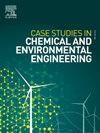Comparison of porous and non-porous biochar for trimethoprim removal: Quantifying uncertainty in sorption and thermodynamic parameters over different pH and temperature
Q1 Environmental Science
Case Studies in Chemical and Environmental Engineering
Pub Date : 2025-07-18
DOI:10.1016/j.cscee.2025.101264
引用次数: 0
Abstract
This study conducted a comparative analysis of non-porous (CN400) and porous (CN600) biochar for trimethoprim (TMP) removal under varying pH (3, 7, and 10) and temperature conditions (20, 26, and 32 °C). Bayesian nonlinear regression was used to quantify uncertainty in both adsorption isotherms and derived thermodynamic parameters. The biochar was characterized by yield, point of zero charge, scanning electron microscopy with energy-dispersive X-ray spectroscopy, Fourier-transform infrared spectroscopy, X-ray diffraction, and N2 adsorption-desorption isotherms. The experimental data were statistically interpreted using the pseudo-second-order, modified intraparticle diffusion, and Langmuir isotherm model. The results showed that the non-porous structure of CN400 had a smaller surface area than that of CN600 (4 vs. 372 m2 g−1, respectively). However, CN400 exhibited a higher sorption capacity (9.44 vs. 3.48 mmol kg−1) at pH 7 and 20 °C, and significantly faster sorption kinetics than CN600 (2 vs. 87 min, respectively). Based on frontier molecular orbital theory calculations, TMP sorption onto CN400 was driven by three synergistic mechanisms including electrostatic attraction, hydrogen bonding, and π–π electron donor–acceptor interactions. Interestingly, raising the temperature from 20 to 32 °C resulted in a 1.8-fold increase in Qmax for CN400 and up to a 6.9-fold increase for CN600, attributed to enhanced pore diffusion kinetics at high solution temperatures. Bayesian inference-based thermodynamic analysis confirmed that the TMP sorption process was both spontaneous and exothermic. Our statistical findings suggest that tailoring CN400/CN600 biochar could offer a synergistic strategy to accelerate TMP adsorption and maximize sorption capacity in water treatment systems.

多孔和非多孔生物炭去除甲氧苄啶的比较:在不同pH和温度下定量吸附和热力学参数的不确定度
本研究在不同pH值(3、7和10)和温度条件(20、26和32°C)下,对无孔(CN400)和多孔(CN600)生物炭去除甲氧苄啶(TMP)进行了比较分析。贝叶斯非线性回归用于定量吸附等温线和导出的热力学参数的不确定性。通过产率、零电荷点、扫描电子显微镜(x射线能谱)、傅里叶变换红外光谱、x射线衍射和N2吸附-脱附等温线对生物炭进行了表征。实验数据采用伪二阶、修正粒子内扩散和Langmuir等温线模型进行统计解释。结果表明,CN400的无孔结构比CN600具有更小的表面积(分别为4和372 m2 g−1)。然而,CN400在pH为7和20°C时表现出更高的吸附量(9.44 vs. 3.48 mmol kg−1),并且吸附动力学显著快于CN600(分别为2 vs. 87 min)。基于前沿分子轨道理论计算,TMP在CN400上的吸附是由静电吸引、氢键和π -π电子供体-受体相互作用三种协同机制驱动的。有趣的是,将温度从20°C提高到32°C, CN400的Qmax增加了1.8倍,CN600的Qmax增加了6.9倍,这是由于高溶液温度下孔隙扩散动力学的增强。基于贝叶斯推理的热力学分析证实了TMP的吸附过程是自发的,也是放热的。我们的统计结果表明,定制CN400/CN600生物炭可以提供一种协同策略,以加速TMP的吸附,并最大化水处理系统的吸附能力。
本文章由计算机程序翻译,如有差异,请以英文原文为准。
求助全文
约1分钟内获得全文
求助全文
来源期刊

Case Studies in Chemical and Environmental Engineering
Engineering-Engineering (miscellaneous)
CiteScore
9.20
自引率
0.00%
发文量
103
审稿时长
40 days
 求助内容:
求助内容: 应助结果提醒方式:
应助结果提醒方式:


